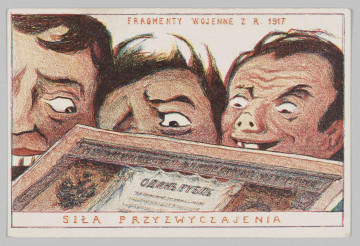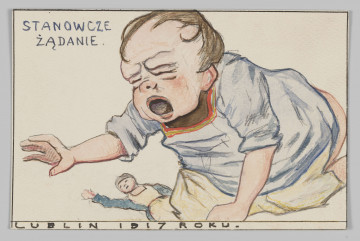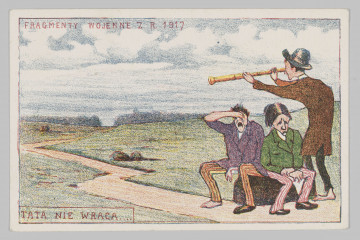
Force of habit
1917
National Museum in Lublin
Part of the collection: Legion postcards
In August 1914, the underground Polish Military Organisation (POW) was established in the Kingdom of Poland. Among those recruited were members who later became soldiers of the Polish Legions and volunteers for the Polish-Bolshevik War. Many of them graduated from the Peasant Officer School in Warsaw. There were also citizens of Lublin among them. A commemorative photograph from 1916 shows two graduates of the Private Male Gymnasium in Lublin, known as the Lublin School – Wacław Policzkiewicz and Jan Arnsztajn – among people in Austrian uniforms and civilian clothes.
Wacław was the son of Henryk Policzkiewicz, a businessman from Lublin. He co-organised a scout team named after Zawisza Czarny at the Lublin School, from which he graduated in 1914. He was active in the Polish Military Organisation under the pseudonyms Wacław Ordon and Migurski. In December 1916, on behalf of the POW troops, he welcomed the commander of the Polish Legions, Józef Piłsudski, who had arrived in Warsaw. As a Polish Army volunteer, he took part in the Polish-Soviet War. He served in the 1st Infantry Regiment. He died during the Kiev expedition on 13 June 1920 near Borodianka. He was buried near the railway station Iskorosti (Korosteń) near Żytomierz.
Jan came from an assimilated Jewish family. His mother Franciszka was a translator and poet, his father, Marek Arnsztajn, a doctor. Engaged in pro-independence activity, they kept weapons and ammunition as well as secret POW documents in their house at 2 Złota Street in Lublin. Their son graduated from school in 1915. Under an assumed name, Jan Ćwiek joined the Polish Legions. He then became adjutant to the Supreme Command of POW. Under the pseudonym Jerzmanowski, he took command of the Lublin detachments of the Peacekeepers. After Poland regained independence, he served in the Polish Army. He was seriously wounded in one of the battles with the Bolsheviks in August 1920. After being released from the reserves, he completed his medical studies. He ran a medical practice in his hometown. Suffering from tuberculosis, he died in 1934. He was buried in the military cemetery in Powązki.
Author / creator
Dimensions
cały obiekt: height: 13,8 cm, width: 9 cm
Object type
postcard
Technique
sepia
Material
paper
Creation time / dating
Creation / finding place
Owner
The National Museum in Lublin
Identification number
Location / status

1917
National Museum in Lublin

1917
National Museum in Lublin

1917
National Museum in Lublin
DISCOVER this TOPIC
Museum of King Jan III's Palace at Wilanów
DISCOVER this PATH
Educational path